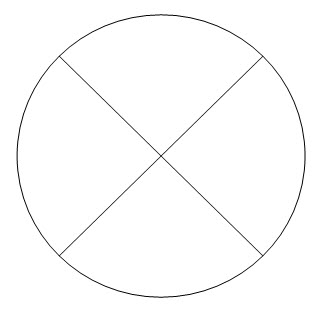The circle can by itself represent these ideas but that is not enough to take us very far forward. So I next recognised that each of us has real needs, and each of us has at the same time the potential to meet these needs in others. There are four of these needs. They split the circle like this:

The axes are deliberately diagonal: I hated the idea that we might be back on the conventional economist’s graph already. We’re not. Each of these quadrants has equal positive value for example, but by using horizontal and vertical axes this might not be obvious.
Each quadrant represents a type of human need. One is for material well being. We all need air, water, food, shelter, clothing, warmth, and more besides to survive. In our modern world we believe we need much more than that.
Another is for emotion. Just start with the needs inherent in a person’s relationship with their mother and move on from there: there is no one who can survive as a healthy human being without emotional relationships.
Next there is a need for intellectual development. We all need language. We must learn to provide for ourselves within the society in which we live. We are curious.
And, perhaps most contentiously (although it seems to me absolutely unambiguously), a person has a need for meaning. I call that their purpose. It could be called a spiritual need. I would be happy with that, but know that might alienate some, and I think purpose, in any event more encompassing. Either was, in I stress that it is definitely not religion. This is the quest for the answer to the question ‘why am I here?’ Unless that question is addressed it seems pretty unlikely to me that a person can achieve their potential.
You can lay them on the diagram like this (using M = Material, E = Emotion, I = Intellectual and P – Purpose):

The allocation of the quadrants is arbitrary. It’s just the one I use. Another would do just as well.

It is great to see such a genuine voice driven by an ethical goal. The difficulty with modern economics is that the assumptions and language are so entrenched on a materialist paradigm that one needs a significant paradigm shift where existing tools and languages are abandoned. For example, environmental costs are traditionally deemed externalities. However, if we make environment preservation a core focus, then we need to start from scratch. And I wonder whether more theorising has impact or more action. For example, Prof. Yunus who won the Nobel Prize for his work in micro-credit has actually turned economics upside down. But the actions came first, and the modelling later. Even now, many economists try to ‘fit’ his ideas to traditional paradigms.
Objection:
Your four-quadrant model – while I will admit, I find it attractive – appears to carry some problems from the outset.
1. It imlpies all four needs you identify are equal. For example, that we need sustenance (M) as much as we need emotion (E). What might this equality ammount to?
2. It implies that all four needs are equal, regardless of context. In – for example – an extreme situational setting like Hobbes’ state of nature, M might be far more important – i.e. needed and demanded by an individual far more – than E. Or think of Somalia. To the average Somalian, M probably trumps E most of the time.
3. It implies everything is covered by these four quadrants. I find that doubtful. However, I admit I can’t now think of something else that deserves a chunk of the circle…I just find it very unlikely that there is nothing else.
1 and 2 can probably be answered satisfactorily by saying that the quadrants can – depending on context, time, person etc – be varied in size to reflect accordingly.
3, I think, is more problematic.